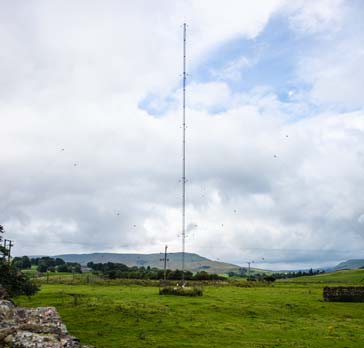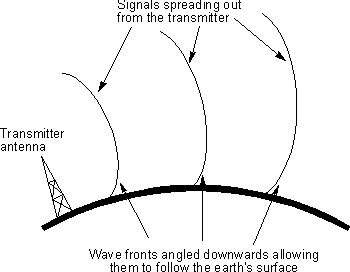Ground Wave Propagation Tutorial
Ground wave propagation is a form of signal propagation where the signal travels over the surface of the ground, and as a result it is used to provide regional coverage on the long and medium wave bands.
Ground wave propagation is particularly important on the LF and MF portion of the radio spectrum. Ground wave radio propagation is used to provide relatively local radio communications coverage, especially by radio broadcast stations that require to cover a particular locality.
Ground wave radio signal propagation is ideal for relatively short distance propagation on these frequencies during the daytime. Sky-wave ionospheric propagation is not possible during the day because of the attenuation of the signals on these frequencies caused by the D region in the ionosphere. In view of this, radio communications stations need to rely on the ground-wave propagation to achieve their coverage.
A ground wave radio signal is made up from a number of constituents. If the antennas are in the line of sight then there will be a direct wave as well as a reflected signal. As the names suggest the direct signal is one that travels directly between the two antenna and is not affected by the locality. There will also be a reflected signal as the transmission will be reflected by a number of objects including the earth's surface and any hills, or large buildings. That may be present.

In addition to this there is surface wave. This tends to follow the curvature of the Earth and enables coverage to be achieved beyond the horizon. It is the sum of all these components that is known as the ground wave.
Beyond the horizon the direct and reflected waves are blocked by the curvature of the Earth, and the signal is purely made up from the diffracted surface wave. It is for this reason that surface wave is commonly called ground wave propagation.
Surface wave
The radio signal spreads out from the transmitter along the surface of the Earth. Instead of just travelling in a straight line the radio signals tend to follow the curvature of the Earth. This is because currents are induced in the surface of the earth and this action slows down the wave-front in this region, causing the wave-front of the radio communications signal to tilt downwards towards the Earth. With the wave-front tilted in this direction it is able to curve around the Earth and be received well beyond the horizon.

Effect of frequency on ground wave propagation
As the wavefront of the ground wave travels along the Earth's surface it is attenuated. The degree of attenuation is dependent upon a variety of factors. Frequency of the radio signal is one of the major determining factor as losses rise with increasing frequency. As a result it makes this form of propagation impracticable above the bottom end of the HF portion of the spectrum (3 MHz). Typically a signal at 3.0 MHz will suffer an attenuation that may be in the region of 20 to 60 dB more than one at 0.5 MHz dependent upon a variety of factors in the signal path including the distance. In view of this it can be seen why even high power HF radio broadcast stations may only be audible for a few miles from the transmitting site via the ground wave.
Effect of the ground
The surface wave is also very dependent upon the nature of the ground over which the signal travels. Ground conductivity, terrain roughness and the dielectric constant all affect the signal attenuation. In addition to this the ground penetration varies, becoming greater at lower frequencies, and this means that it is not just the surface conductivity that is of interest. At the higher frequencies this is not of great importance, but at lower frequencies penetration means that ground strata down to 100 metres may have an effect.
Despite all these variables, it is found that terrain with good conductivity gives the best result. Thus soil type and the moisture content are of importance. Salty sea water is the best, and rich agricultural, or marshy land is also good. Dry sandy terrain and city centres are by far the worst. This means sea paths are optimum, although even these are subject to variations due to the roughness of the sea, resulting on path losses being slightly dependent upon the weather! It should also be noted that in view of the fact that signal penetration has an effect, the water table may have an effect dependent upon the frequency in use.
Polarisation & ground wave propagation
The type of antenna and its polarisation has a major effect on ground wave propagation. Vertical polarisation is subject to considerably less attenuation than horizontally polarised signals. In some cases the difference can amount to several tens of decibels. It is for this reason that medium wave broadcast stations use vertical antennas, even if they have to be made physically short by adding inductive loading. Ships making use of the MF marine bands often use inverted L antennas as these are able to radiate a significant proportion of the signal that is vertically polarised.
At distances that are typically towards the edge of the ground wave coverage area, some sky-wave signal may also be present, especially at night when the D layer attenuation is reduced. This may serve to reinforce or cancel the overall signal resulting in figures that will differ from those that may be expected.
 Written by Ian Poole .
Written by Ian Poole .
Experienced electronics engineer and author.
More Antenna & Propagation Topics:
EM waves
Radio propagation
Ionospheric propagation
Ground wave
Meteor scatter
Tropospheric propagation
Antenna basics
Cubical quad
Dipole
Discone
Ferrite rod
Log periodic antenna
Parabolic reflector antenna
Phased array antennas
Vertical antennas
Yagi
Antenna grounding
Installation guidelines
TV antennas
Coax cable
Waveguide
VSWR
Antenna baluns
MIMO
Return to Antennas & Propagation menu . . .




